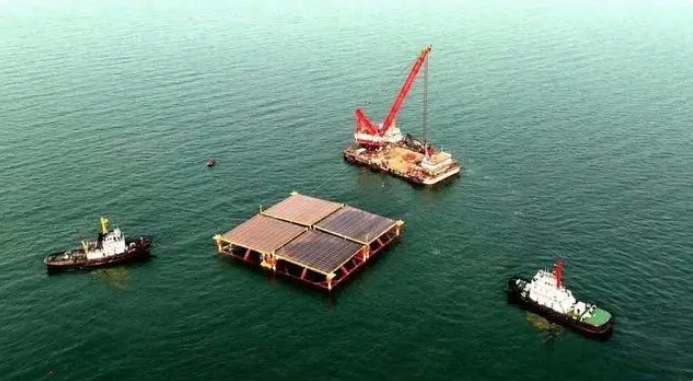On November 24,2023, China’s first semi-submersible offshore PV Generation System platform was put into use on the sea near Yantai, Shandong province. With the expansion of offshore clean energy development, China’s Marine engineering equipment research and development continues to make breakthroughs.
If you are a Yantai citizen who often walks on the beach, you may find that there is a “floating island” recently on the sea six or seven kilometers offshore in the Laishan District of Yantai. This is the first semi-submersible offshore floating Photovoltaic Generator station with independent intellectual property rights developed by CIMC Raffles in China, and delivered to CIMC Marine Technology (Yantai) Co., LTD. The offshore equipment, which looks like a floating island, is a semi-submersible offshore Photovoltaic System platform, which is more than the size of four basketball courts and generates up to 400 degrees per hour. From the naked eye, this floating photovoltaic power station seems to be a small floating island, but this naked eye judgment is ignoring the distance, the floating applied photovoltaics station is 10 kilometers away from Yantai Raffles Marine engineering Research Institute. The real floating photovoltaic power station at sea is composed of four groups of 720 photovoltaic panels of 1900 square meters “big MAC”, you know, a group of 23 meters long,21meters wide photovoltaic panels than a basketball court is larger.
The power generation platform is equipped with four floating body arrays, with a total installed capacity of 400 kilowatts, and can operate safely in open sea areas with wave heights of 6.5 meters, wind speeds of 34 meters per second and tidal ranges of 4.6 meters. According to reports, this semi-submersible equipment is currently used as a demonstration project to supply power to Marine scientific research bases in nearby waters. China has the conditions to develop offshore photovoltaic sea area of about 710,000 square kilometers, the estimated installed capacity of more than 70 gigawatts.
Offshore photovoltaic is an emerging branch of the photovoltaic industry, if the offshore photovoltaic anthropomorphism, the industry should still be in the ignorant childhood. Compared with the more well-known onshore photovoltaic projects, offshore photovoltaic power generation is equivalent to moving the “photovoltaic power station” from the land to the ocean, the water surface is open without shelter, the sunshine is long and the sea reflects light, which is more beneficial to improve the power generation, the power generation can be 5% to 10% higher than the land photovoltaic. Offshore photovoltaic power stations are divided into two categories: pile base fixed and floating. At this stage, the pile base with a water depth of less than 5m is the main one, and the floating type can be used when the water depth is more than 5m. Pile foundation fixed Marine photovoltaic power station is the power generation equipment fixed in the offshore or beach area, mainly suitable for shallow water depth of the sea, in the deeper sea will face greater technical and economic pressure; The floating Marine photovoltaic power station has a wider application range, or will become the mainstream form of Marine photovoltaic power stations in the future.
Once electricity is created, how to use it out is also a key.
In the public perception, there are no more than the following ways, but from the point of view of cost, the feasibility is not large:
-Connecting to the grid is the easiest way to think about it. However, it should be seen that even if the mature onshore new energy generation accounts for more than 35%, it has an impact on the power grid system, and the absorption potential of new energy is still to be tapped, at the same time, the new energy into the power grid is also planned by indicators, and this road is not the most ideal route.
- Laying the submarine cable alone, which is a huge expense, is obviously not feasible at present.
- To store electricity and transport it to land? This is also a path that has been rejected because it is too expensive. At present, the cost of 1 W·h capacity of energy storage equipment is about 2 to 3 yuan, which is equivalent to the cost of 2000 to 3000 yuan per watt hour of electricity (1 kW·h).
If the cost reduction is the ultimate proposition of floating photovoltaic at sea, the ultimate proposition must have its goal orientation, and this goal refers to industrialization.
Obviously, it is easy to see that only by realizing industrialization, offshore floating photovoltaic power stations can achieve scale benefits, so as to truly achieve parity, and clean energy affordable electricity from the sea can “fly into ordinary people’s homes.” This is a huge industrial chain: upstream, from crystalline silicon raw material suppliers, to silicon rods, silicon electricity, silicon wafers and other production enterprises; In the middle stream, there are photovoltaic cell enterprises that produce single crystal cells and polycrystalline cells, and photovoltaic module enterprises that manufacture photovoltaic glass, photovoltaic backplane, single crystal modules, polycrystalline modules, Solar Mounting Brackets, batteries, bus boxes, intelligent inverters, energy storage systems, etc. Until the downstream commercial photovoltaic power station, household photovoltaic power station energy storage and island microgrid.
Post time: Nov-24-2023
